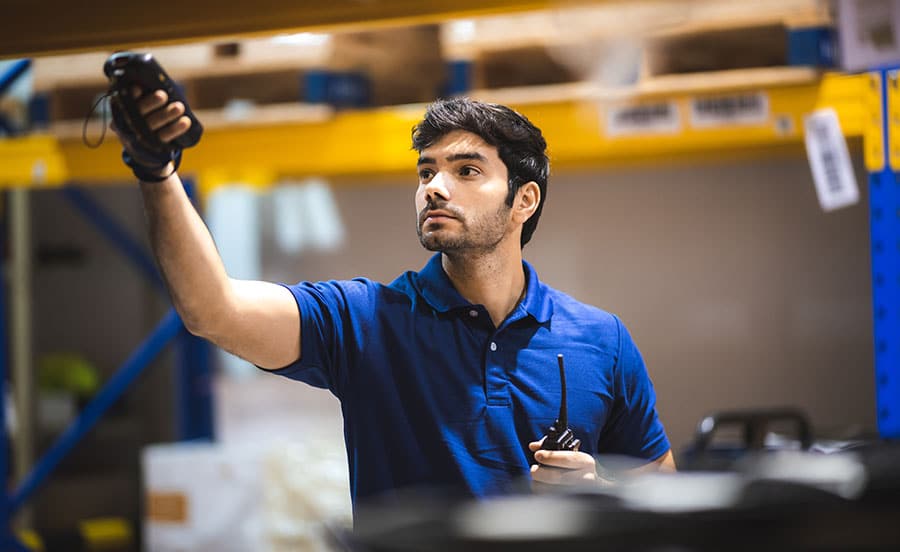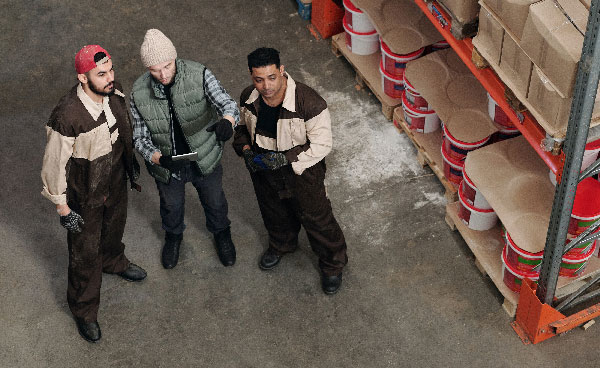
by Dan Keller, Senior Consultant, Lucas Systems
According to research by Technavio, the U.S. foodservice market is expected to grow by over 28% CAGR. Adding to the challenge, demand for warehouse workers continues to grow as companies build new distribution centers and expand existing facilities to satisfy SKU proliferation driven by the growing demand for healthy, organic, specialty, and premium foods. Within this scenario, labor productivity, speed, and accuracy has never been more critical in foodservice distribution.
In response to these market realities, some foodservice DCs are experimenting with robotic solutions or other capital-intensive automation with a goal of reducing warehouse labor cost and labor availability dependencies, knowing that the tight labor market is a problem that will persist for the long haul. This approach is not only expensive but projects often take years to complete. But what if you could get more work done with less workers by reducing wasted in-warehouse worker travel? And…you could get a solution up and running in a few months.
In-warehouse travel is the lynchpin
In a conventional, non-automated selection process, travel represents the majority of the time in a DC selector’s day. Warehouse workers following an RF-picking process will typically spend as much time walking or driving between pick locations than they do pulling products from bins, slots or racking locations. Hands-free voice technology can significantly reduce time at the pick face, but it does not address the travel time between selections. For years, DCs have devoted significant efforts to reducing travel through software solutions like slotting, conventional automation, and lean process initiatives. Those efforts are taking on new urgency as ecommerce growth boosts labor demand.
Lucas Systems has taken a different approach to reducing travel that builds on lean process engineering and applies AI-based optimization technologies to increase selection density and reduce travel in selection and other travel-intensive DC activities. What’s also important in today’s working environment is that this type of AI-based optimization does not require any changes to warehouse layouts or storage systems, and the upfront investment cost is a fraction of robotic picking solutions.
Improvements driven by pallet-matching and path optimization
Using AI to optimize DC processes has proven to be powerful in foodservice distribution, particularly in pick-to-pallet operations. Many Lucas customers report double-digit gains in productivity without any fundamental changes to their selection processes. Although the biggest productivity gains are seen in each picking, significant gains can be made in case picking, replenishment, and other activities where workers are visiting many locations per work assignment. In grocery and foodservice DCs, AI-based optimization has demonstrated in-warehouse travel savings of 15-30% in case pick to pallet applications. Travel reduction is accomplished through two main components – Intelligent pallet matching and path optimization.
Intelligent pallet matching – The Lucas system uses algorithms to create optimized assignments. Unlike simple route-based pallet sequencing in a WMS, order priority, selection location, travel cost, product attributes, and other factors are evaluated to create optimal multi-pallet units of work within seconds.
Traditional picking systems generally use simple pick sequences that direct workers up one aisle and down the next in a snaking pattern. With our solution, path optimization algorithms use a virtual map of a facility to compute an ideal travel path that does not follow a strict location sequence. The algorithms take into account a user’s starting and end points, aisle travel restrictions (one-way aisles, for example) and other factors. Path optimization is applicable to picking, replenishment and other activities where individual work assignments span widely dispersed locations.
Intelligent pallet matching and path optimization have reduced travel 30-70 percent compared to current processes and pick paths. A number of Lucas customers have more than doubled pick rates in cart pick operations and grocery and foodservice DCs have seen 15-30 percent savings in travel time in case pick applications, which often translates to 8-15 percent productivity gains.
In addition to the productivity benefits, through a process called dynamic prioritization, waveless order picking (sometimes called “order streaming”) is supported. In effect, rather than processing orders by wave, dynamic prioritization continuously reprioritizes, matches, and releases work as new orders are received.
Worker engagement grows with productivity, accuracy gains
To illustrate some of these optimizations in action, Lucas customer Ace Endico switched over to Lucas after utilizing a scan-based system for several years. With the previous scan-based process, selectors at Ace Endico could pick two orders in a single trip through the warehouse by grabbing two strips of case labels. Selectors had to manually manage the two strips of labels to be sure they were using the right labels, adding time to every pick. The issue was even more pronounced in the narrow-aisle PIR (planned inventory reserve) sections of the warehouse in which selectors could pick several orders at a time using man-up trucks.
With the new Lucas system, the server automatically merges the picks for more than one assignment into an optimal pick sequence, and prints the labels for all of the orders in pick sequence in a single strip. The Lucas mobile application gets the pick assignment from the server and tells selectors which location is next and selectors can periodically check that they are using the correct label by asking the voice-based system. Selectors are also directed to put each case on the correct pallet, helping to avoid other shipping errors. Besides speeding up the selection process, the mobile applications also improved the efficiency of the PIR merge process by which the items picked in the PIR aisles are merged onto order pallets picked in the other aisles. Ace Endico experienced a greater than 25 percent increase in productivity, while also reducing errors by 44% within months of implementing the Lucas system.
But just as importantly, from a labor perspective, since selectors were paid on an incentive basis, their pay packages increased dramatically, making it a real win-win. The efficiency improvements with the Lucas solutions also allowed Ace Endico to switch from a five-day work week to a four-day, 10-hour schedule, something the workers embraced.
So in an era where organizations are looking for any competitive advantage to attract and retain workers, Ace Endico was able to overcome some of the complexities of the warehouse to create the most optimum pallets and optimize selector efficiency and speed. And they did it in a way that minimized disruption and cost, truly benefitting the company, its workers and ultimately their customers.
Many foodservice DCs have maxed out their productivity gains and travel savings through process design and improved slotting. And given today’s changing market factors, most facilities are looking for other ways to eliminate travel that don’t require fixed, inflexible automation systems. Systems that offer a more cost-effective, flexible, and scalable alternative to traditional material handling systems, without requiring any changes to warehouse layouts or storage systems, are increasingly viable alternatives, representing a low-risk, high-return solution for reducing travel that can be implemented quickly and at a far lower cost than automation.

Dan Keller, Senior Consultant at Lucas Systems, has been designing and delivering innovative software solutions for warehouses and distribution centers for 30+ years.
As an early evangelist for voice technology, he has participated in dozens of industry-first implementations of voice and other technologies in industries spanning food and beverage, retail, healthcare, industrial supply, and manufacturing. He has held roles in sales, marketing, solutions design and delivery during his 20+ years at Lucas Systems and is a frequent speaker at supply chain and logistics conferences, including the Warehousing Education and Research Council, the Wine and Spirits Wholesaler’s Association, the Foodservice Distribution Conference, the Healthcare Distributors Management Association and more.
About Lucas Systems, Inc.
Lucas Systems helps companies transform their distribution center operations and continuously adapt to changing market dynamics. We dramatically increase worker productivity, operational agility, and customer satisfaction.
Our solutions are built on 24-plus years of deep process expertise and smart software using AI and voice technologies. Our solutions feature Jennifer™, the brain, voice, and orchestration engine that drives performance improvement gains. Make the smartest moves at the lowest cost with Jennifer™. For more information, visit www.lucasware.com.





